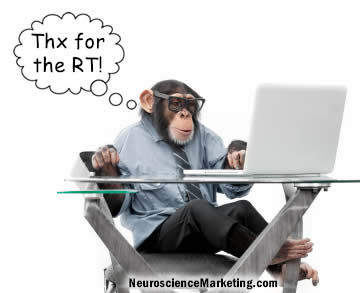What Monkeys Teach Us About Social Media
 A social media platform like Twitter is a kind of social science laboratory that can be sliced in various ways. (For some serious social media slicing and dicing, check out the work of my friend Dan Zarrella.)
A social media platform like Twitter is a kind of social science laboratory that can be sliced in various ways. (For some serious social media slicing and dicing, check out the work of my friend Dan Zarrella.)
Traditional community dynamics apply – there are high-status individuals who have legions of followers and wield considerable influence, and lower-status individuals who have little impact on the community. Principles like reciprocity are at work – if one individual retweets another’s post, it creates a little social obligation for the second to reciprocate. (As in real life, if there’s a big status difference between the two people, the drive to reciprocate may be much smaller or even nonexistent.) New research on monkeys shows that the tracking of social gestures may be hardwired into our brains.
Duke researchers studied the brain activities of monkeys as they gave juice to other monkeys. While the monkeys would usually consume the juice themselves if they could, when that wasn’t possible they tended to give it to other monkeys. The scientists found that while several areas of the monkey brains lit up as they either consumed or gave away the juice, one area in particular, the anterior cingulate gyrus, was activated only when they gifted the juice to another monkey. The scientists believe that acts of social generosity are recorded by this brain structure.
This particular experiment didn’t examine how the monkey brains responded to the generosity of others or how those social gestures might be processed and recorded, though it would be surprising if something similar wasn’t taking place.
Most scientists think that acts of social generosity and altruistic behavior provided an evolutionary advantage to primates, since community and social structures were key to their survival.
While we don’t know that human brains operate exactly like those of the monkeys in this experiment, it is probable that there is substantial similarity. Human behavior is far more complex, of course, but the basic wiring for social behavior is no doubt still part of our brains.
From Juice to Likes
Social media tools like Twitter provide an opportunity for us to interact with others in a relatively simple fashion. We can give or receive useful information (and funny cat videos), offer compliments or criticism directly, etc. We can also grant little favors to others by sharing, liking, +1-ing, their content and ideas.
Is it unrealistic to think that our brains are as good at tracking our social favors as the monkeys are about doling out sips of juice?
Neuromarketing takeaway: Be generous with those favors, your brain (and probably everyone else’s) is keeping score!
